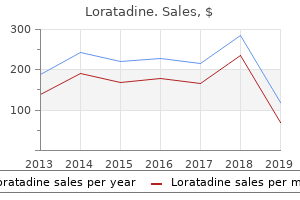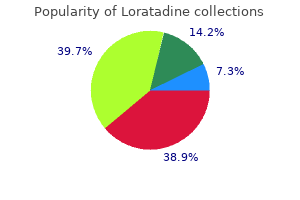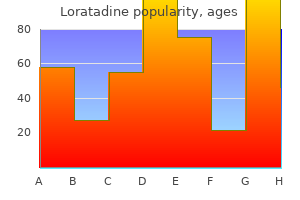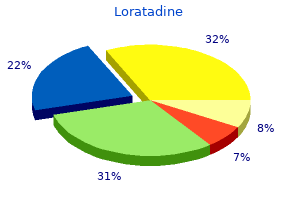

 5100 Springfield St. Suite 108, Dayton, Ohio 45431-1274
5100 Springfield St. Suite 108, Dayton, Ohio 45431-1274Loratadine
"Order loratadine online from canada, allergy shots memphis tn".
By: J. Onatas, M.B. B.A.O., M.B.B.Ch., Ph.D.
Professor, Stony Brook University School of Medicine
Mitsuhashi S allergy medicine mixing order on line loratadine, Yazaki M allergy symptoms to kiwi fruit best purchase loratadine, Tokuda T allergy symptoms pain purchase loratadine us, et al: Biochemical characteristics of variant transthyretins causing hereditary leptomeningeal amyloidosis. Manenti L, Tansinda P, Vaglio A: Eprodisate in amyloid A amyloidosis: A novel therapeutic approach Oka N, Fukumori T, Takahashi M, et al: Secondary amyloidosis of the bladder causing macroscopic hematuria. Hayashi T, Kojima S, Sekine H, et al: Primary localized amyloidosis of the ureter. Inoue K, Takahashi M, Hamamoto Y, et al: An immunohistochemical study of cytokeratins in skin-limited amyloidosis. Ahmed Q, Chung-Park M, Mustafa K, et al: Psoriatic spondyloarthropathy with secondary amyloidosis. Laakso M, Mutru O, Isomaki H, et al: Mortality from amyloidosis and renal diseases in patients with rheumatoid arthritis. Plante-Bordeneuve V, Said G: Transthyretin related familial amyloid polyneuropathy. Hamidi Asl L, Fournier V, Billerey C, et al: Fibrinogen A alpha chain mutation (Arg554 Leu) associated with hereditary renal amyloidosis in a French family. Garcia-Herola A, Prieto M, Pascual S, et al: Progression of cardiomyopathy and neuropathy after liver transplantation in a patient with familial amyloidotic polyneuropathy caused by tyrosine-77 transthyretin variant. Bellotti V, Merlini G: Current concepts on the pathogenesis of systemic amyloidosis. Kurosu M, Ando Y, Takeda S, et al: Immunotactoid glomerulopathy characterized by steroid-responsive massive subendothelial deposition. Buxbaum J, Gallo G: Nonamyloidotic Monoclonal immunoglobulin deposition disease: Light-chain, heavy-chain, and light- and heavychain deposition diseases. Ronco P, Plaisier E, Aucouturier P: Monoclonal immunoglobulin light and heavy chain deposition diseases: Molecular models of common renal diseases. Helin H, Pasternack A, Falck H, et al: Recurrence of renal amyloid and de novo membranous glomerulonephritis after transplantation. Pasternack A, Ahonen J, Kuhlback B: Renal transplantation in 45 patients with amyloidosis. Ogawa H, Mizuno Y, Ohkawara S, et al: Cardiac amyloidosis presenting as microvascular angina: A case report. Masugata H, Mizushige K, Senda S, et al: Comparison of left ventricular diastolic filling with myocyte bulk modulus using Doppler echocardiography and acoustic microscopy in pressure-overload left ventricular hypertrophy and cardiac amyloidosis. Moyssakis I, Triposkiadis F, Rallidis L, et al: Echocardiographic features of primary, secondary and familial amyloidosis. Engvall C, Henein M, Holmgren A, et al: Can myocardial strain differentiate hypertrophic from infiltrative etiology of a thickened septum Itoh M, Ohmori K, Yata K, et al: Implantable cardioverter defibrillator therapy in a patient with cardiac amyloidosis. Oki T, Fukuda N, Iuchi A, et al: Left atrial systolic performance in the presence of elevated left ventricular end-diastolic pressure: Evaluation by transesophageal pulsed Doppler echocardiography of left ventricular inflow and pulmonary venous flow velocities. Kornberg A, Rapoport M, Yona R, et al: Amyloidosis of the pericardium in multiple myeloma: An unusual cause of bloody pericardial effusion. Dubrey S, Pollak A, Skinner M, et al: Atrial thrombi occurring during sinus rhythm in cardiac amyloidosis: Evidence for atrial electromechanical dissociation. Iwai M, Ishii Y, Mori T, et al: Cholestatic jaundice in two patients with primary amyloidosis: Ultrastructural findings of the liver.

Because the ideal method for treating disorders mediated by abnormal plasma components is to remove the offending substance selectively allergy symptoms morning and night order 10 mg loratadine amex, a variety of online filtration and column adsorption techniques have been introduced or proposed allergy patch test purchase discount loratadine. Ligands bound to a column matrix may be relatively nonspecific chemical sorbents allergy symptoms in kids generic loratadine 10mg with amex, such as charcoal or heparin, or specific ligands, such as monoclonal antibodies and recombinant protein antigens. Two such columns are commercially available: one using staphylococcal protein A and the other using negatively charged dextran sulfate cellulose beads. Staphylococcal protein A has high affinity for the Fc portion of IgG1, IgG2, and IgG4 and for immune complexes containing these IgG subtypes. The relation is valid for blood volumes during red blood cell exchange or for plasma volumes during plasmapheresis if the target solute remains primarily within the intravascular compartment. A similar technique, heparin-induced extracorporeal lipoprotein precipitation, uses low pH and negatively charged heparin to precipitate lipoproteins and remove the precipitate by filtration online (H. The number and percentage of each cell type collected can be varied by adjusting the site of collection along the interface or by changing centrifugal force, blood flow rate, or rate of cell removal. Plasma is separated from cells by filtration and then passed through parallel adsorption columns to remove low-density lipoproteins from a patient with homozygous familial hypercholesterolemia. Table 119-1 Common Indications for Therapeutic Cytapheresis Erythrocytapheresis Acute complications of sickle cell disease Prophylaxis for recurrent stroke Frequent severe pain crises Hyperparasitemia (malaria, babesiosis) Hemochromatosis Leukapheresis Leukemia with hyperleukocytosis syndrome Cutaneous T-cell lymphoma (photopheresis) Peripheral blood stem cell collection Plateletpheresis Symptomatic thrombocytosis Erythrocytapheresis Red blood cell exchange (erythrocytapheresis) is used most often to manage or prevent the acute vasoocclusive complications of sickle cell disease. Compared with manual exchange transfusion, mechanical cell separators offer the advantages of speed and ease and reduce the risks of rapid blood volume alteration and increased blood viscosity that may occur with simple transfusion. Automated procedures can be performed with all centrifugal instruments and programmed procedures allow accurate prediction of target hemoglobin concentration and percent hemoglobin A (HbA) at the conclusion of the procedure. Sickle cell anemia occurs in individuals who are homozygous for a single mutation in codon 6 of the -globin gene, resulting in substitution of a single amino acid. Although the defect appears simple, the pathophysiology of the vasoocclusive crises is complex, involving hemoglobin polymerization, change in cell shape, adhesion to endothelial cells, dysregulated nitric oxide homeostasis, and release of free hemoglobin and inflammatory cytokines. No clinical data support a single optimal level of HbA; however, as few as 30% of transfused cells markedly decrease blood viscosity. At mixtures of 50% or greater, resistance to membrane filterability approaches normal. In nonemergency situations, such levels can often be achieved with a simple transfusion regimen. For simple and exchange transfusions, raising the level of Hb A to between 60% and 70% while lowering the level of Hb S to 30% is generally efficacious, although even higher levels of HbA may be required to treat an ongoing crisis. Clinical indications for exchange transfusion in patients with sickle cell anemia remain controversial, with limited controlled study data available. Simple transfusion has been shown to improve renal concentrating ability and splenic function in young sickle cell patients; exchange transfusion improves exercise tolerance and reverses the periodic oscillations in cutaneous blood flow associated with this disease. Such observations have encouraged the use of exchange transfusion for acute complications of sickle cell disease such as acute chest syndrome, priapism, cerebrovascular accident, and hepatic and retinal infarction. Exchange transfusion for sickle cell patients has also been used for prophylaxis during pregnancy and before surgery, although prophylactic transfusion in these settings is controversial. The only randomized trial of transfusion during pregnancy has shown that prophylactic transfusion sufficient to reduce the incidence of painful crises did not reduce other maternal morbidity or perinatal mortality. The risk of intrauterine growth restriction may be reduced by prophylactic exchange transfusion; however, the study is limited by the retrospective observational nature of the data. The results of this and other studies suggest that if prophylactic preoperative exchange transfusion is used, it should be limited to patients undergoing high-risk procedures in whom simple transfusion could not effectively raise the Hb A level to 70% or higher.

These advances in knowledge coupled to development in technology promise a bright future for engineering specific cell populations to provide targeted therapies allergy forecast spokane wa purchase loratadine visa. Dendritic Cells Delamarre L allergy symptoms 11 effective 10mg loratadine, Mellman I: Harnessing dendritic cells for immunotherapy allergy medicine nasal spray buy loratadine 10 mg without prescription. Donor Leukocyte Infusions and Suicide Genes Di Stasi A, They S-K, Dotti G, et al: Inducible apoptosis as a safety switch for adoptive cell therapy. Williams the use of gene transfer to treat human diseases has now efficacious in a limited number of instances. Proof-of-principle successes proven in several monogenic diseases-both hematologic and nonhematologic-have been published and widely publicized in the past decade. Despite these successes, the occurrence of serious adverse events in some trials related to insertional mutagenesis has tempered the enthusiasm accompanying these reports but has also stimulated rapid development of safer vector systems. This chapter discusses the basic biology of vector systems applicable to blood diseases, discusses details of the application of gene therapy to blood diseases using specific trials as examples of this technology, and discusses modifications in vector systems driven by clinical experience that predict future trials. The chapter also discusses the prospects that the evolving field of somatic cell reprogramming may generate alternative cellular targets for genetic engineering. This is termed germline gene therapy and is currently banned in the United States and around the world. In contrast, introduction of new genetic material into specialized cells of the body with no risk of the new genetic material being passed onto subsequent generations is termed somatic gene therapy. The ultimate goal of gene therapy would be to correct a genetic disease by replacement of the defective gene in situ. Such gene replacement could be envisioned via a process termed homologous recombination. Homologous recombination in mammalian cells is widely practiced in laboratories but up to now has been relatively inefficient. Advantages of this approach would include a reduction in the risk of inadvertent disruption or dysregulation of expression of a critical gene sequence and regulated (appropriate level and distribution) expression of the normal (replaced) gene. However, the frequency of this event (in contrast to random chromosomal integration) in mammalian cells makes therapeutic use of homologous recombination impractical at this point. Methods to effect homologous recombination have improved in the past 5 years and may make this goal attainable in the future. The requirements for successful application of our current gene transfer technology for treatment of human diseases include knowledge of the abnormal gene sequence responsible for the disease phenotype and the availability of the corresponding normal gene sequence. In addition, the cells responsible for the disease phenotype must be identified and accessible for genetic manipulation. Finally, a means of introducing and expressing the correct gene sequence in cells such that the disease phenotype can be reversed is needed. This latter requirement has been, although effectively accomplished more than 2 decades ago in murine studies, the most difficult to consistently meet in human applications using current gene transfer technology. Since the early development of virus vectors, blood-forming cells have been used as one optimal target for gene transfer studies, and most studies to date use ex vivo approaches to genetic modification. Finally, the blood system is involved as a major dose-limiting organ in cancer therapies and both a target and an effector organ in immune reactions providing a large group of diseases that could theoretically be approached using gene transfer technology. As noted earlier, there are already a large number of monogenic diseases of the blood extensively characterized with more being defined at the molecular level on a regular basis because whole-exome and whole-genome sequencing is being applied to rare disease phenotypes.

Because the drug is being infused in close proximity to the receptors allergy symptoms throat order loratadine 10 mg with amex, only a small amount of opioid is needed allergy shots kelowna discount 10mg loratadine, and the systemic side effects are reduced allergy symptoms 8 week pregnant purchase loratadine paypal. Problems with this delivery system in patients who are not opioid naive include pruritus, respiratory depression, and sedation. If tolerance to the opioid develops and higher doses are required for relief, the incidence of side effects may approach that of systemically administered opioids. The effective dose of gabapentin varies between 900 and 3600 mg/day in divided doses and that of pregabalin is 150 to 300 mg twice a day. The pharmacokinetics of gabapentin are unique in that it has a ceiling effect related to a saturable transport mechanism in the gut, such that the effects of this drug may plateau during dose escalation. Gabapentin and pregabalin need to be renally dosed in patients with decreased creatinine clearance. Other, generally less effective anticonvulsants used for neuropathic adjuvants include phenytoin, carbamazepine, lamotrigine, topiramate, and tiagabine. However, because of their anticholinergic side effects, they should be started at doses of 10 to 25 mg at bedtime and used with caution in elderly patients and in patients who have cardiac conduction abnormalities or bladder outlet obstruction. Combination therapy with gabapentin and nortriptyline has been shown to be more effective than either drug alone in patients with diabetic neuropathy and postherpetic neuralgia. Corticosteroids given epidurally, intravenously, or orally are useful as antineoplastics. Doses of 16 to 100 mg of dexamethasone are needed to reduce vasogenic edema in spinal cord compression,10 but lesser doses (6-20 mg/day) can be helpful in patients with plexus injuries. Patients must be monitored for the development of oral or esophageal candidiasis and steroid-induced delirium. Calcium and sometimes vitamin D supplementation (especially for denosumab) are often needed. Adjuvant Analgesics Adjuvant analgesics are a diverse class of medications, which typically have indications for conditions other than pain. They have analgesic properties and are often used when an opioid regimen alone is unable to provide sufficient analgesia or is associated with dose-limiting side effects. Modafinil (Provigil), a novel psychostimulant with a mechanism of action different than the amphetamine derivatives, which is approved for narcolepsy and fatigue related to multiple sclerosis, has also been found to be effective for opioid-related sedation. A thorough dental evaluation and prompt treatment of infections can minimize the discomfort arising from underlying periodontal disease and caries; secondary bacterial, viral, and fungal infections; and mucositis. Preventive regimens include saline, sodium bicarbonate, chlorhexidine gluconate rinses, acyclovir, antifungals, and ice. The use of colony-stimulating factors in the treatment of oral mucositis remains investigational. Viscous lidocaine (Xylocaine) or a slurry of sucralfate, dyclonine, or Kaopectate in diphenhydramine provides symptomatic treatment of mucositis pain. Recently, GelClair, a bioadherent gel that adheres to the oral surface, creating a protective barrier for irritated tissue, has had mixed results in small clinical trials. However, caution is warranted because of reported side effects of glaucoma and cardiac problems. Detailed bowel preparation recommendations can be found, but no regimen has been studied in a controlled fashion. Commonly used stool softeners and stimulants include docusate sodium, senna, lactulose, and polyethylene glycol.

These are currently being pursued at this time as well by several different groups allergy shots for bee stings quality 10 mg loratadine. These findings have prompted the introduction of several novel allergy medicine cat dander purchase 10 mg loratadine visa, orally available kinase inhibitors allergy symptoms september order loratadine amex. Fostamatinib disodium is a multitargeted kinase inhibitor whose primary target is syk. Because of off-target effects of this drug, tolerability was not optimal with many patients noting diarrhea, fatigue, cytopenias, hypertension, and nausea. Notable with this treatment was that 90% had a 50% or greater nodal response but with 26% also having class specific lymphocytosis. Toxicity with this treatment included pneumonia and liver function abnormalities but not myelosuppression. Mutations in Btk in humans result in a more profound humoral immune defect with absent B-cells, immunoglobulin, and infections. At the highest dose, toxicity was quite mild, including grade 1/2 nausea, diarrhea, infections, rash, and fatigue. Of note, only three of 61 patients have gone off study because of progressive disease. Additionally, response has been noted independent of associated genetic abnormalities del(17p13. Chimeric Antigen Receptor T-Cell Therapy To date, efforts at reverting T-cell immune suppression toward the tumor cells have been relatively limited. Additionally, stress associated with job performance, insurance coverage maintenance, and disease-related symptoms are most significant in this age group. When therapy is initiated for this group of patients, consideration of aggressive intervention to promote prolonged remission duration is always a top priority. Several retrospective studies have documented a short survival time (9-12 months) and a particularly high frequency of both bacterial and opportunistic infections in this patient population. New therapeutic agents such as bendamustine, ofatumumab, and alemtuzumab have been evaluated in this setting and have modest activity and produce relatively short remissions. These patients may be older with advanced disease and have more pronounced lymphadenopathy and splenomegaly. Secondary Malignancies in Chronic Lymphocytic Leukemia Chronic lymphocytic leukemia is associated with an increased risk of secondary malignancies. The diagnosis is generally made after examining the histology of a rapidly enlarging lymph node, which typically reveals large-cell lymphoma. Our institution prefers dose-adjusted infusional therapy Hypersensitivity in Chronic Lymphocytic Leukemia to Mosquitoes and Insect Bites and Treatment Patients with chronic lymphocytic leukemia commonly exhibit an exaggerated cutaneous response to insect bites. The reaction is characterized histologically by the presence of a dermal infiltrate composed of a mixed population of T and B cells, eosinophils, and eosinophilic granule protein. The extent of eosinophilic degranulation may also correlate with the severity of symptoms. Clinically, these patients present with recurrent, painful, bullous eruptions that may be traced to an insect bite in some instances. Identification and avoidance of known triggers may be useful in some cases, but most patients are unable to identify the inciting exposure.
Order 10mg loratadine amex. Food Allergies : Signs Symptoms And Treatment For Food Allergy.